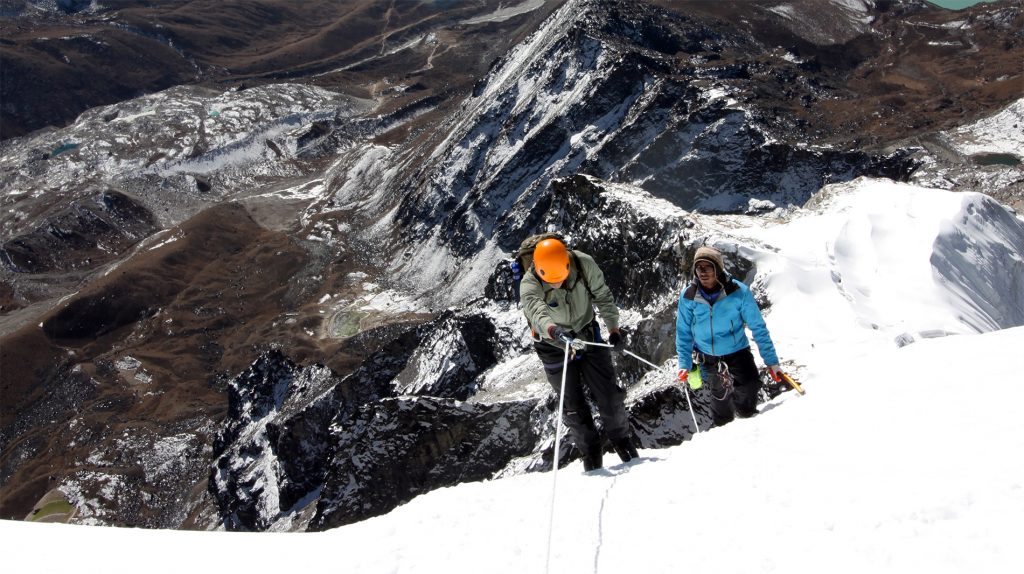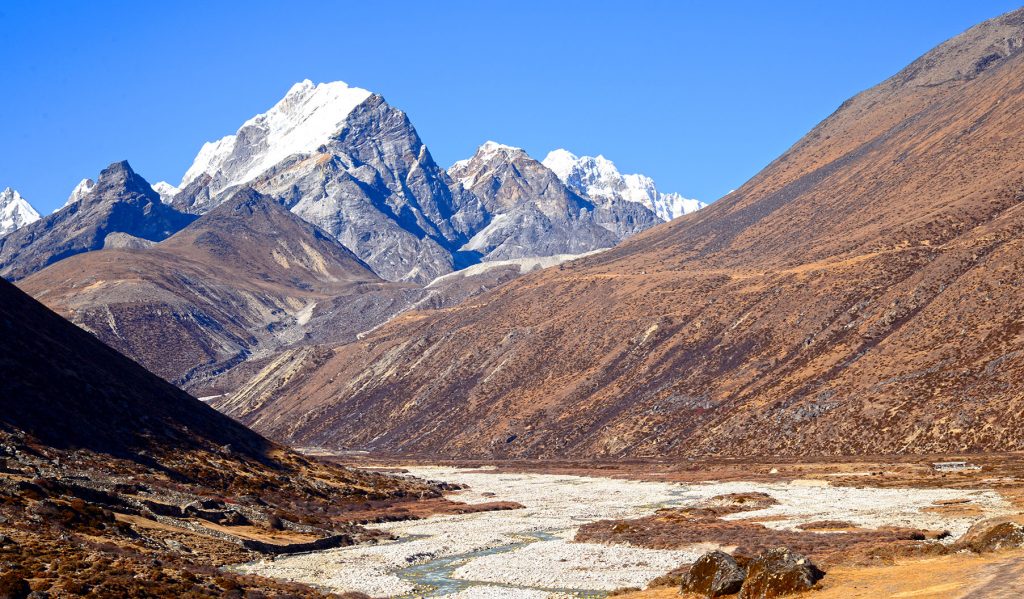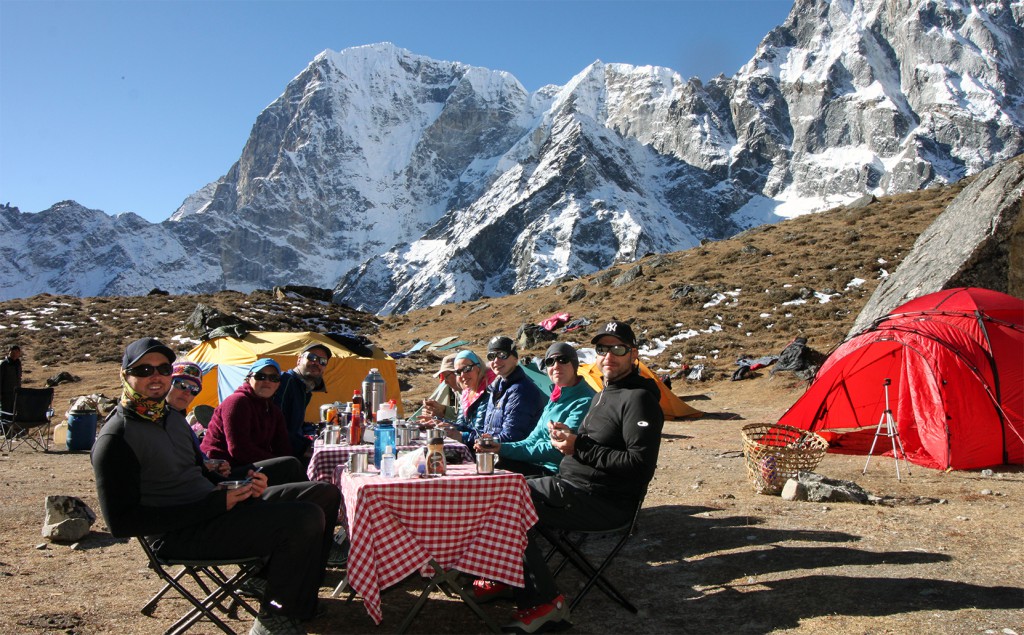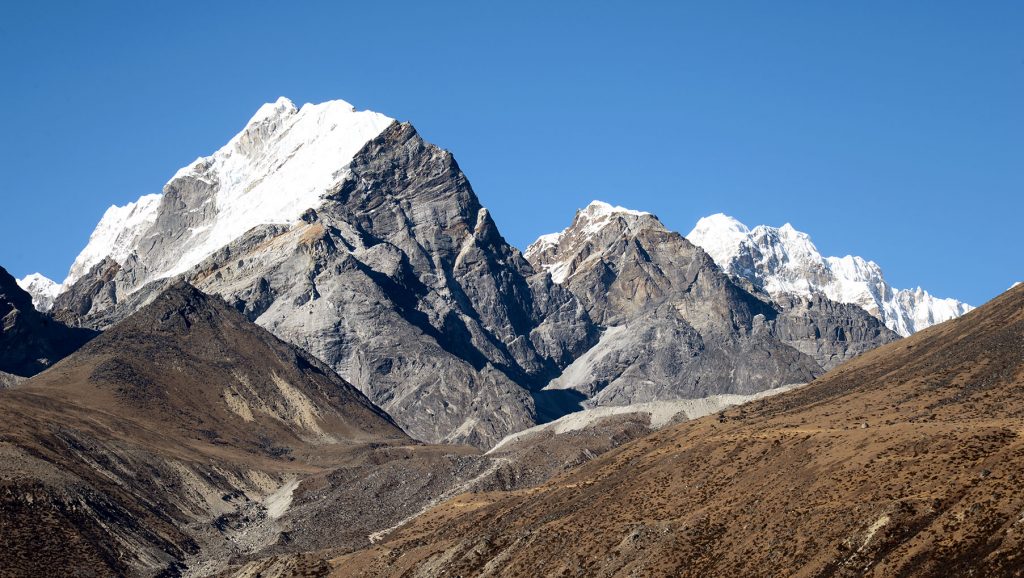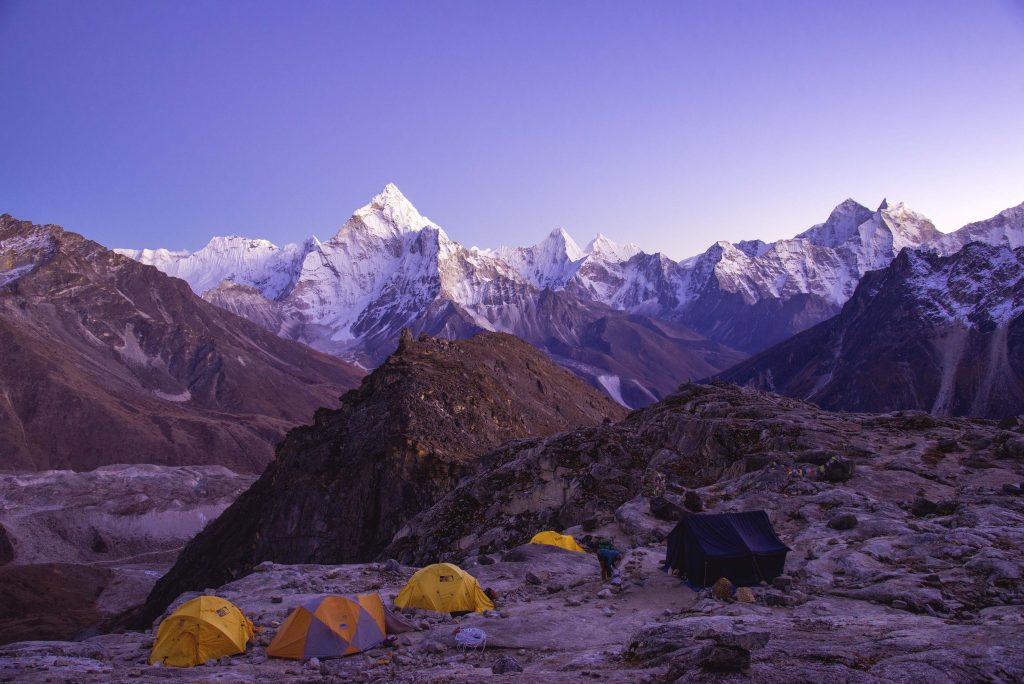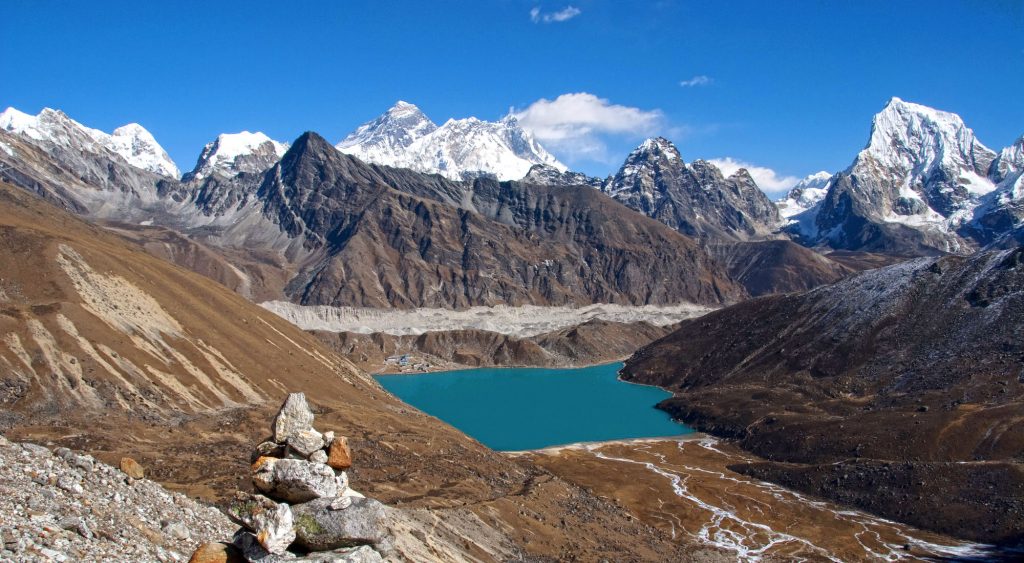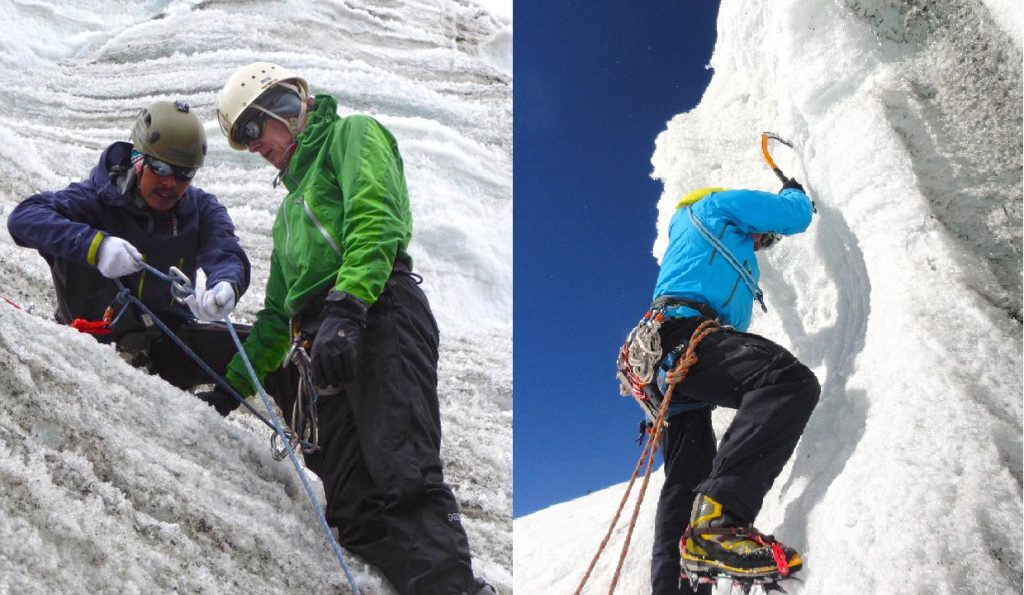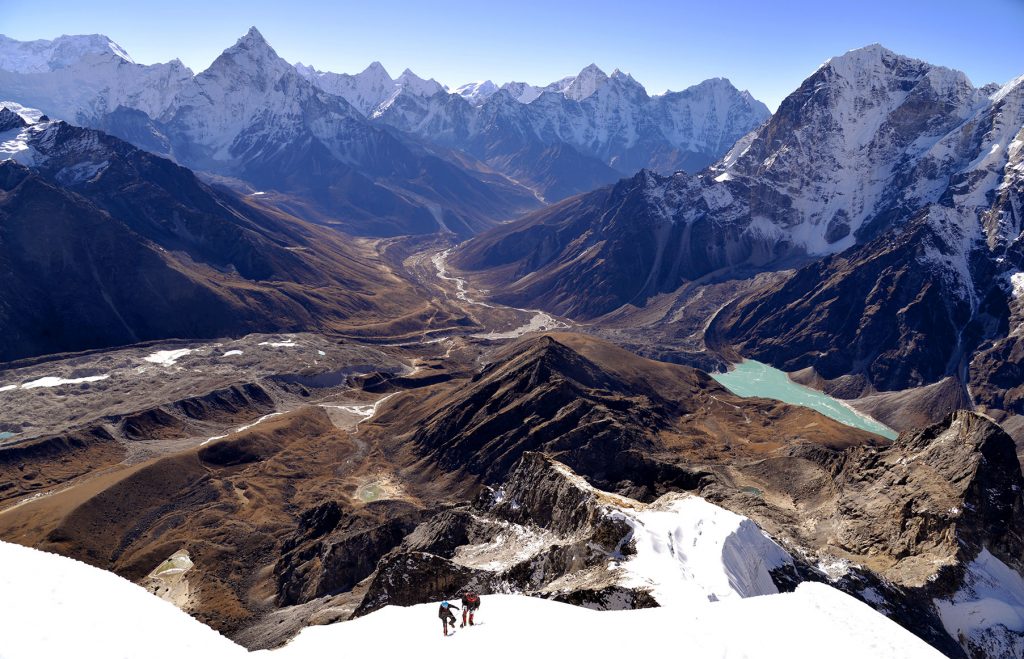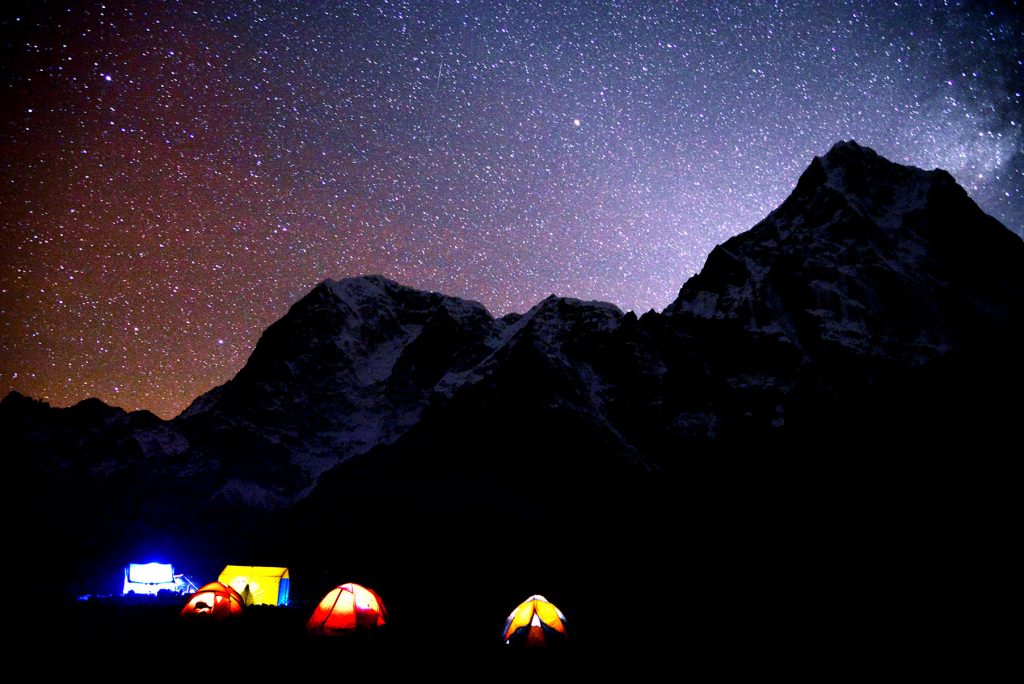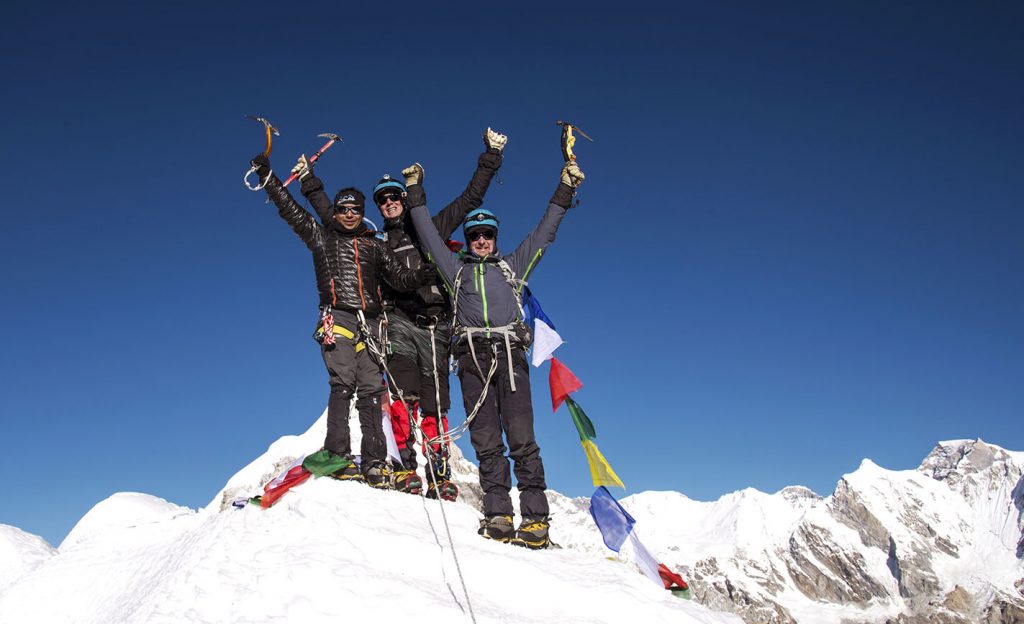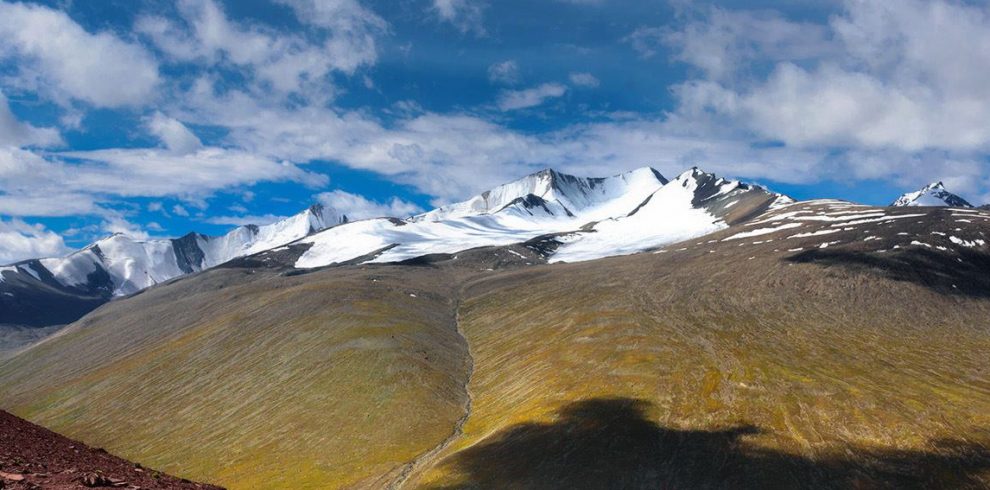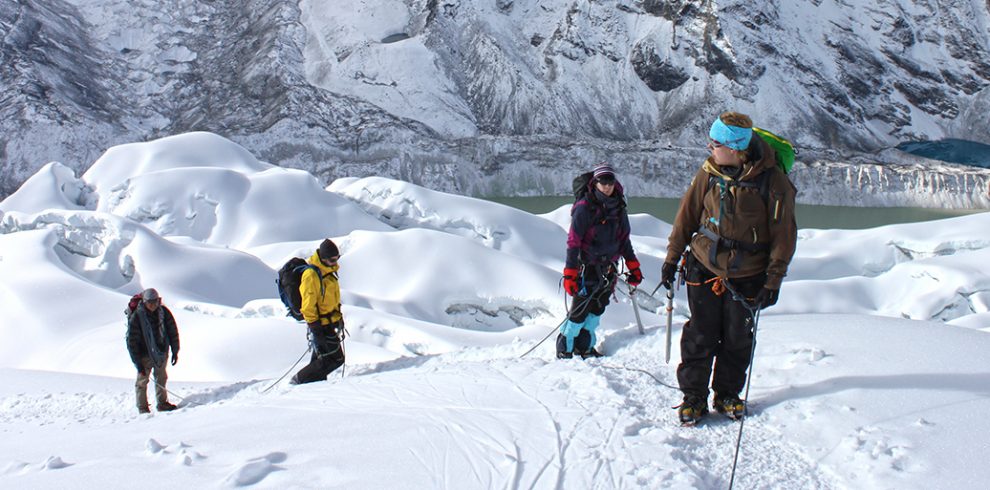This is a perfect climbing adventure for those who have the desire to climb mountains but hasn’t had the opportunity to try it before. We encourage such people with no climbing experience or for those who wants to refresh their climbing skills and experience.
Lobuche East (6119 m) is one of the most challenging ‘trekking peaks’ in the Everest region. We plan to ascend the South Ridge to a high snow ramp from where we continue to the summit. Lobuche East is an excellent trekking peak as it is more technical than many other trekking peaks and promises the view of the highest peaks in the world. Lobuche is also taken as a good warm up for climbers seeking to climb the top of the world, the Everest. From the top of the peak a magnificent panorama of the majestic Everest, Lhotse, Nuptse, Amdablam, Pumori and scores of mountains can be seen.
Overview
We begin with a spectacular flight to Lukla (2850 m) and begin our adventure in the Khumbu, the home of Everest! Trekking through high alpine valleys following the milky white rivers we trek through the beautiful Thame valley towards Tibet. Here we have amazing rock faces of different grades of climbing. There is an option for a rock climbing practise here if it is a collective decision taken by the group. We can have a one day Basic rock climbing course on one of these rocks depending on your level of skills. After a night here, we continue our trek to the Dzasampa valley to Lungden. It is only 3 days trek from here to Tibet crossing the Nangpa la if you continue North. From Lungden, we turn East and ascend the astonishingly beautiful Pass, Renjo La (5370 m) from where you can have breathtaking views of Everest, Makalu, Lhotse and the surrounding mountains along with the turquoise Gokyo Lakes. After a couple of nights in Gokyo, we continue to Cho La pass where we will have a high altitude climbing course. There is a beautiful ice wall in the nearby glacier and we will spend a couple of nights here where our instructors will give us a basic climbing course and safety/ rescue instructions.
A day’s hike from here takes us to Lobuche Peak Base Camp. We spend a couple of days at Base Camp and High Camp for rest and acclimatization and to gain back the strength to tackle the final and real challenge.
The climb can be arduous and challenging and require some technical skills with the rope and expertise in climbing; it’s hard for the first time climbers as there are steep and icy slopes on the way, which makes the climb challenging and exciting at the same time.
What makes this trip special
- Spectacular mountain flight to Lukla
- Summit of Lobuche Peak 6119 m
- 4 of the highest mountains in the world (Everest, Lhotse, Makalu and Cho Oyu) seen from the top
- Gokyo valley and lakes, once been voted among the top 5 walks in the world
- Spectacular views from Renjo La and Cho La
- 2 days Ice climbing course on glacier wall
- Summit of Lobuche Peak 6119 m
Itinerary
Once you reach KTM airport and finish with the immigration and custom formalities be prepared to confront the confusion outside the airport which is common in most of the south Asian countries. As you walk out of the Exit door into the passenger pick up area you will see hundreds of people with different sign boards in their hands, taxi drivers looking for fares, hotel touts looking for customers and porters trying to help with the luggage for tips. Please remain calm and do not walk out of the restricted area into the crowd straight away. Remain there and try to find the Hi On Life’s sign board. Once you spot it, walk straight to the signboard and identify yourself. From here we will take care of you.
When you arrive to your hotel you will be briefed about your activities and "do's and don’ts" while your stay in Kathmandu. We will also collect some documents from you. Please have the following things handy when arriving.
Travel/ Medical Insurance (photo copy)
3 passport size photos
Photocopy of your passport.
In the evening we will go for a traditional Nepali dinner at Kathmandu's finest Nepali restaurant to end the day.
After breakfast you will be taken for a half day city tour where you will be visiting some historical temples and monuments. You will end your sightseeing with a lunch. After your lunch you will be return to your hotel and your Group leader will give you your trek briefing and issue you your 'trek pack' consisting of a duffle bag, down jacket, sleeping bag, inner liner for your sleeping bag and rain poncho. Your afternoon is free for you to do your packing and purchasing your last minute items for your trek.
A very early morning wake up and transfer to the domestic airport to board our flight which is a small 17 seated Twin Otter or Dornier aircraft. The flight times can be flexible because we need clear weather both in Kathmandu and Lukla to be able to fly. So this can sometimes involve waiting in the terminal for a long time. Once we get the all clear signal we take off to our destination on a 40 min scenic mountain flight to Lukla.
After a cup of tea at Paradise Lodge in Lukla we are treading on the legendary “Everest Highway” which heads downwards through the alpine valley following the “Dudh Kosi” or Milk River (named after its milky color from glacial silt). We reach Benkar after a half a day walk and end our first day here.
The next day we will be walking mostly uphill through the alpine valleys and crossing rivers and reach Namche Bazaar, which is the Sherpa capital of the Khumbu region. On a clear day you get views of Everest, Lhotse, Thamserku, Kusum Kangru, Kwangde and Taweche on the way to Namche.
As we will have gained about 700m that day, it demands a rest and acclimatization day for the following day. We will either rest at Namche or trek to Everest View Hotel where you will have a breathtaking view over Mount Everest, Nuptse, Lhotse and Ama Dablam. You will be back at lunchtime and will have plenty of time to rest to make the following day easier.
The trail starts from the Namche Gompa and leads west past a large array of prayer flags, Mani stones and Chortens. The trail is quite easy and it takes about 3 hours to reach Thamo, where we will have lunch. From Thamo we will start to climb towards Thame. The carved Mani stones on the way are some of the most complex and picturesque in Khumbu. Thame is situated in a magnificent kettle surrounded with beautiful and dramatic mountains. Be prepared on awesome sunsets at clear weather!
After climbing the ridge above Thame we enter the Bhote Koshi Valley where the river Bhote Koshi runs in the middle. Just as the name reveals (Bothe = Tibetian, Koshi = River) this valley leads to Tibet and the famous pass Nangpa La . It takes about 4 hours to reach a village called Marlung, we stop here for lunch. After lunch, it is another one hour to Lungden. There are just four lodges and they are very basic with only 3 to 4 rooms in each of the lodge.
We utilize this day for rest and acclimatization. We will do a short hike towards Nangpa La, to a small “village” called Arie. Usually we meet a lot of Tibetan traders here. They are coming with their fully loaded yak caravans from Tibet to sell their gods in Namche. Before we head back to our lodge we get views of the worlds 6th highest mountain, Cho Oyu and many other beautiful peaks both in Nepal and Tibet. In the afternoon we relax and prepare for the next day.
We start early in the morning, generally at 4 to 5 AM. The first one hour of the trek is quite steep. We reach a small dried out lake, from here the trail is a gentle climb for another 2 hrs and finally we reach a big turquoise green lake. From here, the trail is well trodden stony steps all the way to the top of the pass Renjo La which takes about 3-4 more hours. The view from the Pass is extremely beautiful. We get to see a panorama of Everest, Lhotse, Makalu and dozens of other mountains. The view of Everest is one of the best you can get, as you get to see more of Everest from here than from anywhere else in Nepal. After taking pictures, enjoying the stunning view and have a snack to eat we continue down to Gokyo. It takes about 3 hours.
Today we will take complete rest. We will enjoy the amazing views and let our bodies acclimatize to the altitude. You can contact family and friends back home if the little internet cafe is working and take short walks. Enjoy Cho Oyu South Face (8201m), Cholatse (6440m) and other beautiful mountains up close.
From Gokyo, we descend south and reach the 2nd Lake. From here we cross the Ngo Zumpa glacier towards the east. At the other end of the glacier, we pass beautiful meadows and yak grazing pastures before reaching Thangna. Thangna is a yak grazing pasture and has a few lodges which are open only during the trekking season
We start early and begin to climb a steep hill side. After about an hours climb, the trail becomes less steep and opens up into a beautiful glacial valley. We continue for about an hour through this meadow and reach the bottom of the steep rocky climb below the Chola. The trail is rocky and steep. At few places there are areas for rock falls. Our crew guides us through safe areas and after an hour, we reach the top to the Chola. There are beautiful views of Cho Oyu, Amadablam, Nuptse and the North Face of the infamous Cho Latse. We will set up our camp- you can help the crew with putting up the tents.
Ice Climbing- In the afternoon, our guides will fix ropes at the glacier and begin our ice climbing course with detailed orientation of ice climbing equipments and safety. After the orientation, you will get to try many methods and styles for : Footwork, tool placement, and efficiency. Depending on your level of skills our guides might give you lessons on glacial rescue and lead climbing on multi pitch.
Today we will train on a steeper climbing ice wall on the glacier. We will work on various basic methods and techniques of ice climbing focusing on efficiency and safety.
We begin with a steep descent from the Chola. The trail is quite rough with big stony steps. After a long descent through the rocky terrain, we reach a yak pasture at Dzongla. There are a few lodges here which are open only during trekking season. This meadow becomes vibrant green with various flowers and grasses during the summer and you can see hundreds of yaks enjoying the abundant food, as the yak owners leave their yaks here for grazing. Soon, we are at Lobuche Peak Base Camp.
Today we relax, take shower in our shower tent, eat well and just enjoy the views.
The next day we set up Advance Base Camp. It should take us about four hours to climb over rocky slopes and some snow to high camp. We are set on a small expanse of snow or rock, above a deep, blue lake and close to the mountain.
We start early for the final summit. Immediately from Advance Base Camp we climb huge smooth rock slabs, which sometimes can be a bit sliperry. The gradient is gentle and easy but due to high altitude we move very slow but gradual. After 2 1/2 hour climbing on these rocky slab, we reach the crampon point. From here we start by climbing an ice ramp towards the south East Ridge, which is a mixture of moderately steep snow and ice. Where necessary, we fix ropes along the route. We ascend steadily to a plateau at around 6000m, which is called the false summit. Normally climbers climb to this point but if the conditions are right then we traverse to an exposed ridge, which will follow to the summit slopes. After about 5 hours of steady climbing we reach the far eastern summit, which for us marks our summit.
From the top, we get excellent views of Ama Dablam, Makalu, Lhotse, Everest, Nuptse, Changtse (in Tibet) Pumori, Gyachung Kang, Cho Oyu and the myriad peaks to the west and south. A short victorious moment is spent at the top and then we climb down to Base Camp for a well-deserved rest. The entire climb to the summit and back to Base Camp will take 10 to 12 hrs.
We pack up Base Camp and begin our way back home through an extra ordinarily beautiful valley of Pheriche leaving behind our mountain, Lobuche Peak, behind our back. Stunning views of Cholatse and Taweche can be seen, that towers over us towards the west and massive North West flank of Amadablam right ahead of us. After a break at Pheriche, we continue to descend to a beautiful village of Pangboche. Pangboche is the highest permamnent settlement in the Khumbu.
We begin with a descent to the Khumbu Khola and then a steady climb to the Tyangboche monastery. We will take a long break at Tyangboche giving you opportunity to visit the beautiful moanastary and even enjoy a perfect fika- “Coffee with Chocolate Brownie” with magnificient views of Amadablam. After Tyangboche we climb down to the Dudh Kosi and a steady climb of about 2 hours will bring us to Namche Bazaar.
We will retrace our way back to Lukla.
Early morning flight to Kathmandu
You can spend your free time in Kathmandu for shopping and sightseeing. If you need any help or advise your group leader will be happy to assist you. The last day will be a mixture of sadness of your departure as well as excitement to catch up with your friends and family to tell them about your adventure.
We will drive you to the airport 3 1/2 hours before your departure flight time.
Cost Includes
- All internal transportation in private vehicle
- Both way airfares to Lukla and back to Kathmandu with domestic terminal taxes
- 4 nights in tourist class hotel on bed and breakfast basis while in Kathmandu
- Welcome dinner
- Half day guided city tour with lunch
- Services of English or/and Swedish speaking guide
- 2 Climbing Sherpas for upto 4 climbers and thereafter 1 additional climbing Sherpa for every 4 climbers
- Porter’s and Sherpa’s assistance
- All camping and kitchen facilities with Cook and kitchen helpers
- Use of a personal trek pack consisting of: Duffle bag, down jacket, rain poncho and sleeping bag with an inner-liner
- All meals while on trek
- Afternoon tea/coffee service on arrival at the lodge
- Boiled and treated water 2 times a day while in lodges and 4 times a day while camping
- Twin share accommodation in trekking lodges with shared bath and toilet facilities
- All climbing permits and National Park fees
- Staff insurance, tourist service fee and all taxes applicable as per state law
- 1 North Face VE 25 3-men tent for Each person at Base Camp
- 1 Mountain Hardware Trango 2 tent on twin sharing at Advance Base Camp.
- Hilleberg Atlas dining tent with comfortable tables and chairs
- Cooking tent
- Toilet tent with seating pot
- 4 two-way "walkie-talkie" radios
- Comprehensive Medical kit.
- Please note: the only thing you need to bring for climbing is ice boot and crampons (you can hire them in Kathmandu or Namche Bazaar).
- Cooks and Food: At Base Camp, our skilful and hard working cooks prepare three hot meals each day with a very healthy diet of fresh vegetables, cheeses, eggs, and fresh meat as well, tinned fruits, tinned meats and fish (all meats and fish are prepared separately out of respect for the vegetarians in our midst) and a high dose of carbohydrates from breads, rice and pastas. They supply you with unlimited hot-drinks, the key to successful acclimatization. We have weatherproof kitchens and dining tents, with comfortable chairs and tables.
Cost Excludes
- Personal accident and rescue insurance. You must provide your own rescue insurance
- Mineral water, beer, soft drinks and extra tea/coffee outside of normal meal times
- Private room accommodation in Kathmandu unless a single supplement is paid.
- 2 lunches and 3 dinners in total while in Kathmandu before and after the trek
- Optional tips to guides and porters.
- International airport departure taxes.
- Visa costs.
- Helicopter evacuation in the unlikely situation, although we do arrange for it and make the necessary documents so that you can claim from your insurance.
Map
Nepal
Nepal, a tiny country, nestled in the Himalayas between India and China, is one of the most diverse and fascinating countries in the world. Covering an area of only 147,181 sq. km, Nepal encompasses the world’s highest mountains and the deepest valleys as well as low elevation rain forest. Although the width of the country is only 200Km North to South, Nepal has the highest altitude variation of any country on earth, from 20m above sea level to 8848m above sea level (Top of Everest).
The country is divided in to 3 elevation Zones viz. the low Terrain, the midhill region and the high Himalayas, which contains 1/3 of the Himalayan range with 9 of the world’s highest mountains. This wide diversity of landform gives Nepal an incredible wealth of flora and fauna. Nepal is not only famous for its landscape but also renowned for the friendliness of its people. The people of Nepal are as variable and intriguing as the country’s geography. There are more than 37 ethnic groups with their own language and culture. Hinduism is the official religion, which the majority of the people practice. Many people throughout the country are Buddhist and the two religions have co-existed in harmony over the ages. A small number of people practice Christianity and Islam.
Nepal at a glance:
Longitude: 26’12’ and 30’27’ No Latitude: 80 degree 4′ and 88 degree 12′ East
Population: 24 million
Capital: Kathmandu Area: 147,181 sq. km.
Everest
Mount Everest, named after George Everest, the Surveyor General of British India, lies in the Khumbu region of Nepal. The first summit attempt on Everest was by the British in 1921 and only after 32 years of intense exploration, Everest was finally scaled on May 29th, 1953, by Sir Edmund Hillary and Sherpa Tenzing Norgay under Lord Hunt’s team.
The Nepalese name for Everest is Sagarmatha which means “Goddess of the Sky” and the Tibetan name for it is Chomolungma which means “Mother Goddess of the Earth”. By whatever name you call her, she remains the tallest mountain in the world consecrated in midst of the gigantic mountains and glaciers as though they were her subjects. She truly looks like an Empress in her utmost beauty and glory and has attracted hundreds and thousands of mountain lovers over the years.
Himalayan Mountaineering
Ever since the Himalaya in Nepal has been opened for climbing, it has attracted thousands of mountaineers. Thousands of people have challenged their minds and bodies to conquer these magnificent mountains.
Nepal Himalaya has numerous of mountains which are 7 000 m and higher, which require extensive technical experience and a lot of money to climb. Apart from these technical expedition peaks, there was created in 1978, under the control of the Nepal Mountaineering Association (NMA), a list of mountains, between 5 587 m to 6 654 m, called “Trekking Peaks”. Unlike the technical expedition peaks, which are a complicated and an expensive affair, these “trekking peaks” can be climbed without financial and administrative problems. There are 1 310 identified peaks which are above 6 000 m, one fourth are officially opened for mountaineering.
Your Adventure
This adventure takes you through the Khumbu Valley, the home of Everest and the land of the Sherpas. A spectacular flight to Lukla begins our adventure in the Everest region. Trekking through high alpine valleys following the milky white rivers we ascend to the astonishing pass, Renjo La and then continue to Gokyo where we can see high alpine lakes and glaciers. From here we continue to Cho La Glacier where we will have a high altitude climbing course before we head down to Lobuche Base Camp. We spend a couple of days at Base Camp and High Camp for rest and acclimatization and to gain back the strength to tackle the final and real challenge.
Lobuche East (6 119 m) is one of the most challenging ‘trekking peaks’ in the Everest region. It is moderately technically. We plan to ascend the South Ridge to a high snow camp from where we continue to the summit.
With its alpine valleys and lakes, rugged mountainous landscape, glaciers and scores of gigantic mountains, this region is rated among the ‘five best’ region for trekking in the world. The highlights of this expedition are Renjo La, Gokyo, the climbing course and of course the climb of Lobuche Peak.
Although no previous climbing experience is required you must be very fit and have extensive outdoor experience to participate in this Expedition.
Grading: This expedition is graded III B. Please read our Grading system. .
Please note: Any ascent of a Himalayan peak must be taken seriously. The Group leader will take all factors concerning group fitness and acclimatization, weather and snow condition into consideration when making a decision. While recognizing that this ascent is important to the group, first priority will always be safety. The decision on whether or not you will be able to attempt Lobuche Peak rest with the Group Leader. His/ her decision is final and must be accepted.
Summary
Trek Distance: Approx. 210 km
Maximum altitude: 6119m (20,272ft)
In / Out: Kathmandu
A Day on Your Trek
Although each day is different, considering the weather, general pace of the group and length of the days walk, in general your day begins with a wake up tea at around 6 to 6:30 in the morning. You will then be provided with a bowl of warm water for washing. Then you will need to pack your duffel bag and your daypack and come to the lodge’s diner for breakfast.
After breakfast we will hit the trail and usually walk for about 3 to 4 hours before we stop for lunch. We will give you about an hour and a half rest during lunch, which will also give enough time for the staff to have their lunch and pack. Usually after 3 to 4 hours of walking we finish the days walk by 4 PM. Tea/ Coffee and snacks will be served on arrival to the lodge. Your group Leader will often organize side trips in the afternoon. Your dinner will be served around 7 PM.
Please note: For 6 to 7 days we will be camping. During this period you will be sleeping in Tents and the food will be cooked and served in the dining tent by our staff
High Altitude
On this trek you will be going up to 6 119m, so it is very important to understand the affects of altitude. The greatest provocation is going too high too fast. Hi On Life’s itinerary has been carefully designed to minimize the effects of altitude. We ascend slowly and surely allowing enough time for safe acclimatization.
Headaches and breathlessness are common at altitude which in itself is nothing to worry about. In rare cases, this may worsen to Acute Mountain sickness (AMS), so a close watch is kept on all trekkers by the group leader who is trained to recognize the symptoms of AMS which are severe headaches, nausea, lethargy, loss of appetite serious breathlessness even at rest. If any trekkers show such signs they will be descended to relatively lower and safer altitude. The Group Leader’s decision on evacuating such person to a safe altitude is final. Do not medicate yourself without first informing your group leader. Going to altitude slowly with adequate rest and adequate intake of fluid (3 to 4 litres per day), you will most likely have no problems apart from breathlessness on hills which is completely normal as the percentage of Oxygen in the air is relatively lower to that at sea level. The most important thing is not to worry about altitude because our team is there to take care of you.
Staff
Group leader: your most important member of your staff. Our Group leaders are highly trained in all aspects of the trek, conservation, first aid specializing on altitude sickness, emergency procedures and have extensive knowledge of the natural history of the area.
Sirdar: His job is to manage and organize staff duties. He is responsible for the actual operation of the trek.
Sherpas: Their job is to lead your way and distribute equal loads to the porters.
Cook: Responsible for your food. Hygiene of a high standard is taken into consideration in preparing the food.
Porters: They are responsible to transport your duffle bags and their job finishes once they reach the designated lodge. Our porters are provided with Gore-Tex suits, trekking boots, gloves, hats, socks, snow gaiters and snow goggles. Most importantly, we regulate them on a 25 Kg carrying which no other company does. Our clients can therefore feel comfortable knowing that our porters are working in a good humane condition. During the trek you can see porters carrying 60-70 kg and sometimes even more than 100 kg!!)
Weather:
Oct/Nov and March/April
On the trek at lower altitude (2500m to 3500m) during daytime the Max temp can be around 15C to 20C and the Min temp can be 5C to 10C
At higher altitude (3500m to 5000m) the daytime Max temp can be between 5C to 10C and Min temp can be between -6C to OC
On your summit day: You can expect between -10C to -15C + wind chill factor depending on the wind speed
Dec to end of Feb
On the trek at lower altitude (2500m to 3500m) during daytime the Max temp can be around 5C to 10C and the Min temp can be – 5C to 2C
At higher altitude (3500m to 5000m) the daytime Max temp can be between -5C to 10 C and Min temp can be between -8 C to -20C
On your summit day: You can expect between -15C to -20C + wind chill factor depending on the wind speed
Please note that this is just general information and it could vary.
Recommendations for things you should bring:
Clothing:
Head:
- Warm hat wool or synthetic that covers your ears
- Balaclava
- Sunhat
- Glacier sunglasses with side shields, 1 pair ski goggles (optional)
- Headlamp with extra batteries
- Bandana or head scarf, also useful for dusty conditions
- 2 polypropylene or wool mix t-shirts
- 2 polypropylene or wool mix long sleeve t-shirts
- 2 long sleeve thermal underwear shirts, lightweight preferably woolen
- 1 polar fleece pullovers medium weight or 1 heavy wool thermal underwear
- 1 polar fleece jacket, OR Primaloft/ Down light weight jacket
- Gore-Tex jacket with hood, waterproof and breathable
- For high altitude use, 1 very warm goose-down jacket with hood (we provide this)
For trekking:
- 1 pair light weight windstopper gloves
For climbing:
- 1 pr. lightweight poly-liner gloves
- 1 pair mittens, consists of 1 Gore-tex over mitt matched with the very warm polar Fleece mitt liner OR down gloves
Lower Body:
- 1 pair walking shorts
- 1 to 2 pair walking trousers for trekking
- 2 pair lightweight thermal bottoms
- 1 pair medium or expedition weight thermal bottoms OR polar fleece trouser
- 1 pair Primaloft OR light weight down trouser for evenings at Base Camp and Advance Base Camp
- 1 pair Gore-Tex trousers, Waterproof/breathable with side zips
Feet:
1 pair climbing boot preferably for 6000m+ (you can also hire plastic boots in Kathmandu)
1 pair treking /walking boots with good ankle support
1 pair trainers, running shoes and/or sandals for Kathmandu and in camp;
1 pair down booties (optional)
2 pair med-heavy preferably wool socks
2 to 3 pair of liner socks. Polypropylene or wool
2 to 3 pair lightweight trekking socks, poly or wool
Sleeping:
We provide:
- 1 down sleeping bag (rated to – 20 Centigrade or -0 F )
- 1 polar fleece liner
- Exped Down 7W mattres and foam kari-mats.
Rucksack and Travel Bags:
- 1 medium rucksack (40-50 litres)
- We provide you 1 big duffle bags.
- Small padlocks for duffel kit bags.
Assesories:
- 1 small roll of repair tape, 1 sewing repair kit
- 1 cigarrette lighter
- 1 compass or GPS (optional)
- Camera
- Nylon stuff sacks for food and gear storage, large Ziplocs are useful also
- 3 Water bottles (1 litre)
- 1 small folding knife
- Books, playing cards, ipod/mp3 player, games, small musical intruments
- Adequate amount of batteries, etc.
Healthy and trouble free holiday
There are no compulsory vaccinations required for entering Nepal. However please consult a doctor for vaccination against Typhoid, Meningitis, polio, and hepatitis. If you have special dietary requirements or allergies, please through your agent, give us a list of what you can and can’t eat so that we can provide proper food for you.
If you are undergoing a course of prescription medicine, please ensure that you have sufficient supplies for the entire holiday. Some types of drugs including antimalarials have side effects at high altitude; therefore please consult your doctors regarding these drugs. The places you trek are mosquito free and there has been no report on malaria in Kathmandu for the past couple of decades.
Insure yourself
We highly recommend you to take a comprehensive Personal Travel Insurance before leaving home. This should cover for your loss of baggage, airline delays, sickness and accidents. And it should also cover you for Emergency Helicopter Evacuation.
In case of Lukla flight cancellation: Sometimes due to bad weather Lukla flights get cancelled. This may make it difficult for you to connect with international flights. In such an event and if the group as a whole wishes to charter a helicopter, which is an ideal solution to Lukla flight delays, we can arrange for it. Your will need to pay about 400 USD per person.
Money Matters
The ideal currency to bring with you is USD.
In Kathmandu: Each meal will cost around 4 to 6 USD. Plus 10 to 20 USD for your taxis if you wish to go around the city.
On trek: You will need around 6 to 10 USD per day. This money is for your hot showers, chocolates, soft drinks and beers etc and also for small donations in the monasteries.
Tipping
Although tipping is entirely optional and personal matter the following is recommended as a guideline
In Kathmandu: for bellboys, waiters and porters 30 to 50 Nepali Rupees
On the trek: At the end of the trek it is a customary to tip the field staff.
- For Staff: 80-100 USD depending on group size. The group leader will collect the tip and then split it between the staff and put it in envelops so that the trekkers can give it to the staff during the “Farwell Ceremonies”. Your Group Leader is not included in this tip.
- For Group Leader: 30 to 50 USD per person
Some Do’s and Don’ts
Nepalese people treat visitors as special guests. Although they will never rebuke you publicly for unknowingly offending them, we must consider their culture.
While in Nepal please observe the following:
- Full or partial nudity is not accepted
- Over display of affection between men and women, especially in temples and monasteries are discouraged
- Please remove your shoes before entering monasteries and temples
- Never point the soles of your feet at a person or shrine
- Many Hindu temples are closed to non-Hindus. Please ask before entering
- Locals walk around the Mani walls and Stupas in a clockwise direction as a respect and they expect you to do the same although it is not compulsory
“TODAY IS YOUR DAY! YOUR MOUNTAIN IS WAITING, SO… GET ON YOUR WAY!”
DR. SEUSS

